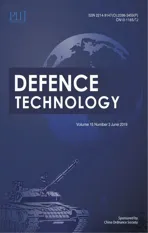Effect of fusion welding processes on tensile properties of armor grade, high thickness, non-heat treatable aluminium alloy joints
2019-07-16VsuChellduriAddnkiRmswmyMlrvizhiBlsurmnin
K.Vsu ,H.Chellduri ,Addnki Rmswmy ,S.Mlrvizhi ,V.Blsurmnin
a Department of Mechanical Engineering,PDPM Indian Institute of Information Technology,Design and Manufacturing,Jabalpur,Madhya pradesh,482 005,India
b Centre for Materials Joining & Research (CEMAJOR), Department of Manufacturing Engineering, Annamalai University, Annamalai Nagar - (P.O), Tamil nadu, 608002, India
Keywords:Gas tungsten arc welding Gas metal arc welding Armor grade aluminium alloy Tensile properties Microhardness
A B S T R A C T AA5059 is one of the high strength armor grade aluminium alloy that finds its applications in the military vehicles due to the higher resistance against the armor piercing(AP)threats.This study aimed at finding the best suitable process among the fusion welding processes such as gas tungsten arc welding (GTAW)and gas metal arc welding (GMAW) by evaluating the tensile properties of AA5059 aluminium alloy joints. The fracture path was identified by mapping the low hardness distribution profile (LHDP) across the weld cross section under tensile loading. Optical and scanning electron microscopies were used to characterize the microstructural features of the welded joints at various zones. It is evident from the results that GTAW joints showed superior tensile properties compared to GMAW joints and this is primarily owing to the presence of finer grains in the weld metal zone (WMZ) and narrow heat-affected zone (HAZ). The lower heat input associated with the GTAW process effectively reduced the size of the WMZ and HAZ compared to GMAW process. Lower heat input of GTAW process results in faster cooling rate which hinders the grain growth and reduces the evaporation of magnesium in weld metal compared to GMAW joints. The fracture surface of GTAW joint consists of more dimples than GMAW joints which is an indication that the GTAW joint possess improved ductility than GMAW joint.
1. Introduction
Among the non-heat treatable Al-alloys that are suitable to plastic working,the Al-Mg alloys(i.e.,5xxx-series)are widely used alloys in industries [1], because of good weldability and superior corrosion resistance. Recently a new Al-Mg alloy AA5059-H136 was developed with more weight percentage of magnesium and better strength properties along with the addition of zinc and zirconium especially for grain refinement. The weight of the armor vehicle can be reduced by using this aluminium alloy,due to its low density compared to steel armor. In general, the most common marine grade tempers for AA5059 aluminium alloy are H116 and H321 which are applicable for catamarans,yachts and ferries.H136 condition was also studied in few investigation cases. This H136 condition makes the alloy more ductile which is used for specific applications such as the structural material supporting ceramic tiles whenever H136 condition was applied to the AA5059 aluminium alloy.This ductile behaviour of the AA5059 aluminium alloy is a highly desirable property to absorb shock in the case of blasts due to the mines as well as backing other armor vehicles.The weight reduction attributes to load more number of weapons,ammunition, personal protecting device and water additionally in the vehicle as reported by khodabakhshi et al.[2].These alloys are also finding wide-ranging applications in shipbuilding industries.Being the low density material compared with that of steel,application of 5xxx series aluminium alloys in ship hull structures is increasing significantly. The use of these alloys in ship building helps in reducing the mass of the structure by about 50%which in turn increases the ship buoyancy. This buoyancy is responsible for increasing the load withstanding capacity, speed and structure stability.
Eventhough Friction stir welding (FSW) is the best suitable process for joining of aluminium alloys in getting a sound joint,some difficulties are encountered in fabrication of hull structures of battle tank and mine protected vehicles due to its complex shape and different orientation. Therefore in fabrication of armored fighting vehicles, GTAW or GMAW are usually employed. Hence welding of armor grade aluminium alloys is most often performed by GTAW or GMAW processes in industries. GTA welding is the most favourable welding process for joining of aluminum alloys because it is capable of producing high quality welds with low cost and easier applicability [3]. Sound welded joints can be attained with armor grade aluminum alloys using the above fusion welding processes, since 5xxx series aluminium alloys are not prone to solidification cracking. While welding of 5xxx aluminium alloys with the same filler metal by GMAW and GTAW processes, mostly same kind of microstructural morphology have been observed.But in case of GMA welded joints,some porosity has been noticed and distortion of the welded joints was more in GMAW compared to GTAW joints. The fracture surface of GMA welded AA5086 Al alloy showed dimple pattern which indicates ductile fracture with some porosity in the matrix [4].
The in detail study on various aspects of micro-structure/property/performance relations and the extent of decrease in mechanical properties under various welding conditions for the blast survival is essential.The factors such as strain rate,temperature and composition of the alloy may have an immense effect on both mechanical properties and mechanism of failure in aluminium alloys [5,6]. Perez-Bergquist et al. [7] analyzed the compression and shear behaviour of 5059 aluminium alloys under both quasi-static and dynamic strain-rates regimes and suggested that 5059 is the best alternative material for 5083 in most of the fighting vehicles due to its better mechanical strength and corrosion resistance.The effect of strain hardening in FCC metals is because of the dislocation to dislocation interaction and volume required to accommodate extra strain reduces,as the strain increases,because of increment in dislocation density.
Paola Leo et al. [8] reported that microhardness values was observed lower in the weld metal region.This is attributed because of alloying elements segregation along the grain boundary. While higher hardness was recorded at the interface i.e., between WMZ and HAZ. This effect is because of weld thermal cycles which promote strengthening of magnesium solid solution. At HAZ region,higher hardness was recorded because of dissolution of soluble particles (Mg2Si, Mg2Al3). It is further mentioned that loss of ductility was due to the insoluble segregated secondary phases,coarser grain size and porosity.Yao Liu et al.[9]reported that GTAW is the best suitable welding technique for joining of AA5083 aluminium alloys compared with GMAW process. They further stated that area of second phase particles that are uniformly distributed are quite harder than that of matrix. Though the weld metal of GMAW consists of large number of second phase particles than GTAW, the existence of pores in GTA welded joint makes the secondary phase particles and finer grain size to suppress. Therefore the mechanical properties get deteriorated in GMAW by the existence of pores. Amir Hadadzadeh et al. [10] reported that softening occurred in the HAZ region while GTAW of Al-6.7 Mg-H136 alloy, because HAZ region undergoes recrystallization and grain growth. Heat input is the most important factor which influences the width of the HAZ region as well as the precipitate size. It is well known that the growth of precipitate size helps in reducing the strength,since the presence of precipitates is also responsible for achieving higher strength in Al-Mg alloy along with the strain hardening mechanism.
F.Zucchi et al. [11] reported that GMAW of AA5083 aluminium alloy produces dendritic grain structure in the weld metal region recrystallized grains in HAZ region and elongated grains in the base metal. Also they stated that weld metal and HAZ regions shows lower hardness compared to base metal.GMA welded joints always shows crack in the weld metal region. This is due to the porosity content in weld metal region. Klenda Mutombo et al. [12] opined that loss of strength and hardness was more predominant in the semiautomatic GMAW welds than fully automatic welds. M.M.James et al.[13]stated that GMAW of 5083-H321 aluminium alloy shows high level of transverse stresses that varies between HAZ and weld metal region i.e.,higher stresses are recorded in HAZ and low stresses in the weld metal region. Similarly longitudinal stresses of 90 MPa was recorded at 22 mm away from weld center line and 122 MPa at weld center line. Chenxiao Zhu et al. [14]observed that large pores were formed near to the side walls adjacent to the weld metal zone of GMA welded aluminium alloy joint. These pores can be controlled by controlling the heat input(i.e., decreasing the welding current and increasing the welding speed).
From the reported literature,it is clear that most of the research works have been carried out on welding of non-heat treatable aluminium alloys, especially on thin sheets of AA5083 aluminium alloy.None of the researcher has highlighted the tensile properties of thick sheets of GTA and GMA welds of AA5059-H136 aluminium alloy joints. So, the current study has been aimed to find out the best suitable process among the fusion welding process like GTAW and GMAW for joining of thick plates of AA5059-H136 aluminium alloys by evaluating the tensile properties of these joints and correlating with microstructure and microhardness results (see Fig.1).
2. Experimental work
The rolled 19 mm thick plates of AA5059-H136 aluminium alloy(AlMg5MnZn) were machined to the required dimensions(300×150 mm2).Tables 1 and 2 present the chemical composition and mechanical properties of base metal respectively.The shielding gas employed to protect the weld pool is high-purity argon gas.The total included groove angle was maintained at 60 in single V butt joint configuration. Al-Mg-Mn (AA5556) was used as a filler metal. Intotal sixteen passes were used to fabricate the joints. The joints were made using the welding parameters presented in Table 3. Fig. 2 shows the images of the welded joints. The tensile specimens were prepared by slicing the welded joints using a power hacksaw and then shaped to the required dimensions(Fig.3)as prescribed by the ASTM standard (see Fig. 4).
Tensile test was carried out using a Universal Testing Machine to determine the properties such as yield strength, tensile strength and elongation of the joints from the smooth tensile specimens.While the properties such as notch tensile strength and notch strength ratio of the joints were determined from the notched specimens. The microhardness values were measured with a load of 0.05 kg load and dwell time of 15 s by Vickers microhardness tester.The specimen(comprises of weld metal,HAZ,and base metal region) for microstructural characterization was prepared by sectioning the fabricated joint and then polished using emery paper followed by etching by a standard reagent called Keller's reagent to reveal the macro and microstructure. The microstructural features across the various zones of the joint were examined by light optical microscopy (OM). The fracture surfaces of the tensile tested specimens were examined by scanning electron microscopy (SEM).
3. Results
3.1. Tensile properties
The transverse tensile properties of the welded joints,which are determined experimentally. Are illustrated in Table 4. The tensile values are taken as a mean of three test results. The parent metal exhibited the yield strength of 283 MPa and tensile strength of 397 MPa. Of the two welded joints, GMAW joints showed the lowest yield strength of 154 MPa and tensile strength of 278 MPa which implies that the strength values are reduced by 30%compared with the GTAW joints. GTAW joints recorded highest tensile strength of 305 MPa. It implies that the strength values of GTAW joints are 9.7% higher than GMAW joints.

Table 1Chemical composition (wt.%) of base metal and filler metal.

Table 2Mechanical properties of base metal and filler metal.

Table 3Welding parameters used to fabricate the joints.
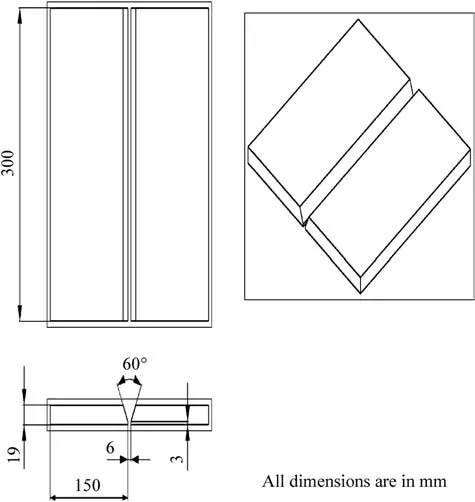
Fig.1. Schematic representation of the joint configuration.
The parent metal showed an elongation of 15.4%. Of the two welded joints,GMAW joints showed the lower elongation of 10.7%which suggests that the elongation values are reduced by 30.5%compared with GTAW joints. GTAW joints showed higher elongation of 12.2%.Notch strength ratio(NSR)is more than one for the parent metal.It is confirmed that the AA5059 alloy falling under the category of notch ductile materials. Of the two welded joints,GMAW joints showed lowest NSR of 0.88 and GTAW joints showed highest NSR of 0.95. This specifies that both the joints falls under notch brittle category.A joint efficiency of 77%for GTAW joints and 70%for the joints made by GMAW process are noted.It shows that GTAW joints exhibited an increment of 10% joint efficiency compared to the GMAW joints.
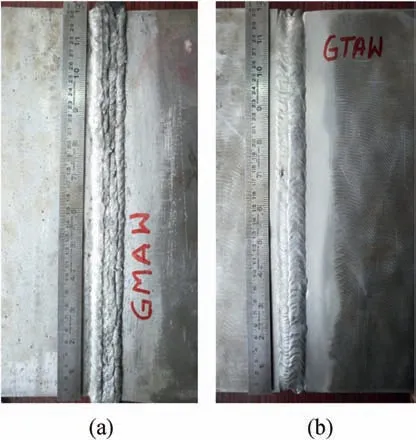
Fig. 2. Photograph of the welded joints (a) GTAW (b) GMAW.
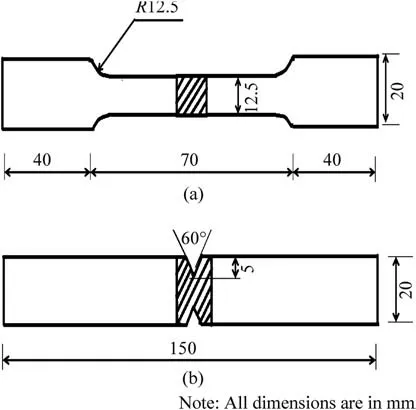
Fig. 3. Dimensions of the tensile specimen (a) Smooth (b) Notch.
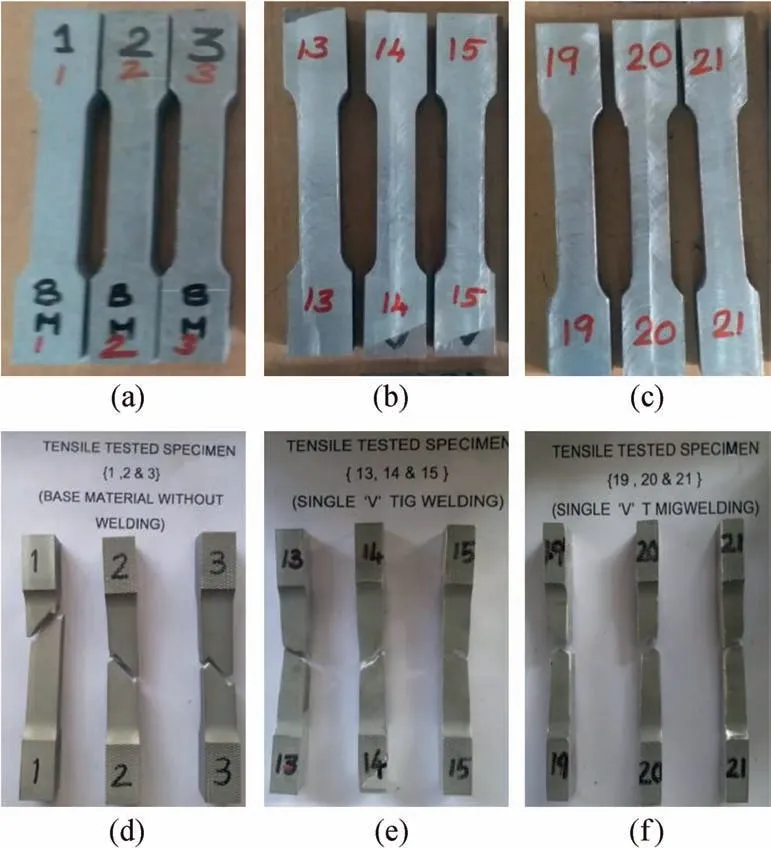
Fig. 4. Photographs of the tensile specimens before (a), (c) & (e) and after testing (b), (d) & (f).

Table 4Transverse tensile properties of base metal and welded joints.
3.2. Microhardness
Microhardness distribution was done across the weld and through the thickness(at six different places with 3 mm spacing in thickness direction from top surface) for GTAW as well as GMAW joints and the corresponding results are depicted in Figs. 5 and 6 respectively. The base metal (unwelded parent metal) showed a hardness value of 94 Hv. The softening zone was identified in the HAZ region upon GTAW of strain-hardened Al-6.7 Mg alloy owing to the grain growth and recrystallization mechanism [15,16].Drastic reduction in the hardness was observed in the weld metal zone for both GTAW and GMAW joints. This is due to the excess heat produced by the additional passes that makes the grain boundary softened.
The low hardness distribution values in the weld metal zone matches with the failure location.The lowest hardness of 60 Hv was recorded in the weld metal zone of GMAW joint.It is inferred that the reduction of hardness by 34 Hv in the weld metal zone owing to the high heat input.GTAW joint records a highest hardness of 78 Hv in the weld metal zone which is 16 Hv higher than GMAW joint.
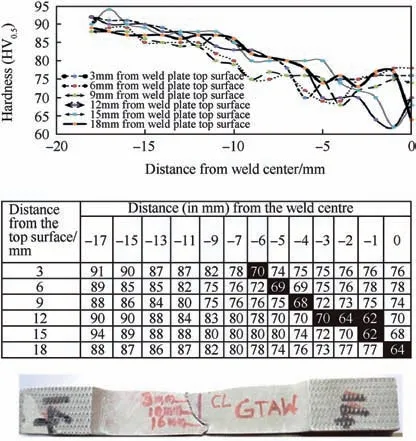
Fig. 5. Microhardness profile of GTA welded joint.
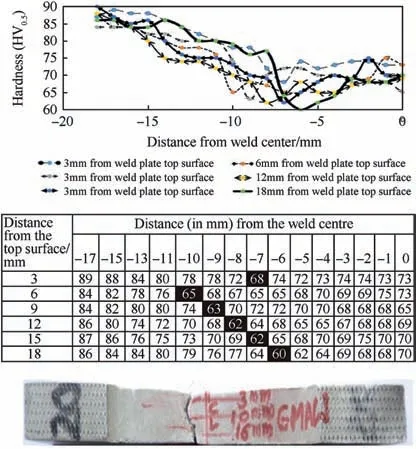
Fig. 6. Microhardness profile of GMA welded joint.
When the tensile specimens are subjected to tensile load, both GMAW and GTAW joints failed in the weld metal zone.
In this investigation, the hardness distribution profiles were mapped with an indentation load of 0.05 kg at a gap of 1 mm for both the joints. From the Fig. 5, it is noted that failure path passes through three low hardness points i.e., 70 Hv at 3 mm from top surface,68 Hv at 9 mm from top surface,and 62 Hv at 15 mm from top surface. Similarly from Fig. 6, it is noted that the failure path passes through three low hardness points i.e.,68 Hv at 3 mm from the top surface, 63 Hv at 9 mm from the top surface and 62 Hv at 15 mm from the top surface.
3.3. Macrostructure
From the macrographs (Figs. 7 and 9), it is noted that GTAW joints are characterized by uniform penetration and reinforcement height and GMAW joints with excess reinforcement height. It is clear that no macrolevel defects were observed in the macrographs of both the joints.
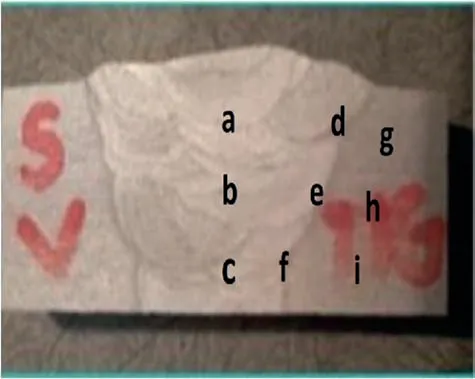
Fig. 7. Macrostructure of the GTAW joint.
3.4. Microstructure
The microstructure taken across the welded joints at different regions are displayed in Figs.8 and 10.The base material consists of cold worked microstructure. Whereas HAZ region consists of elongated coarser grains and weld metal with equiaxed grain structure.On comparing the microstructures of weld metal regions of both GTAW and GMAW joints,it is observed that relatively finer grain structure noticed in GTAW joint due to fast cooling rate and the material appears to be solutionized(Fig.8(b)and(c))with less volume of second phase particles. In case of GTAW joint, second phase particles are distributed uniformly throughout the matrix(Fig.10 (b) and (c)). The presence of second phase particles in the GTAW joint may also influence the strength and ductility. Finer grain structure was observed in the root pass of the weld metal,and gets coarsened upon additional passes and finally results in softened grain boundary that leads to weld metal softening. This softening mechanism is mainly because of the additional heating generated by the successive weld passes which initially recrystallizes the grains and finally led to the grain growth.
The grains at the interface as shown in Fig.10(e)and(f)are very coarse in the case of GMAW joint,whereas in case of GTAW joints,the grains(Fig.8(e)and(f))are comparatively less coarse.The high heat input associated with the GMAW process, makes the alloying elements like magnesium and manganese to evaporate which leads to the reduction of mechanical properties.
3.5. Fracture surface
In order to know the failure behaviour, SEM fractographic examination was carried out on fracture surface of tensile tested specimens. In general, SEM fractography is useful to study the causes and mode of failure (i.e. ductile/brittle). Fractograph of the fracture surface were captured using SEM on tensile tested specimens.
The smooth and notched fractographs of tensile specimens are displayed in Figs. 11 and 12 respectively. The macroscopic observations reveals that the GTAW joints shows a ductile shear fracture surface,whereas GMAW joints shows shear fracture at one side and a fibrous fracture surface on other side. The dimples which are in the shape of knife edged conical are formed by the coalescence of micro-voids that are visible on the fracture surface (smooth) of GTAW joints which confirms that the joints failed in the ductile mode. IN the case of the fracture surface of the GMAW joints,dimple edges in the shape of smooth ellipses are observed. These changes suggest that GTAW joints possess improved ductility than GMMAW joints.
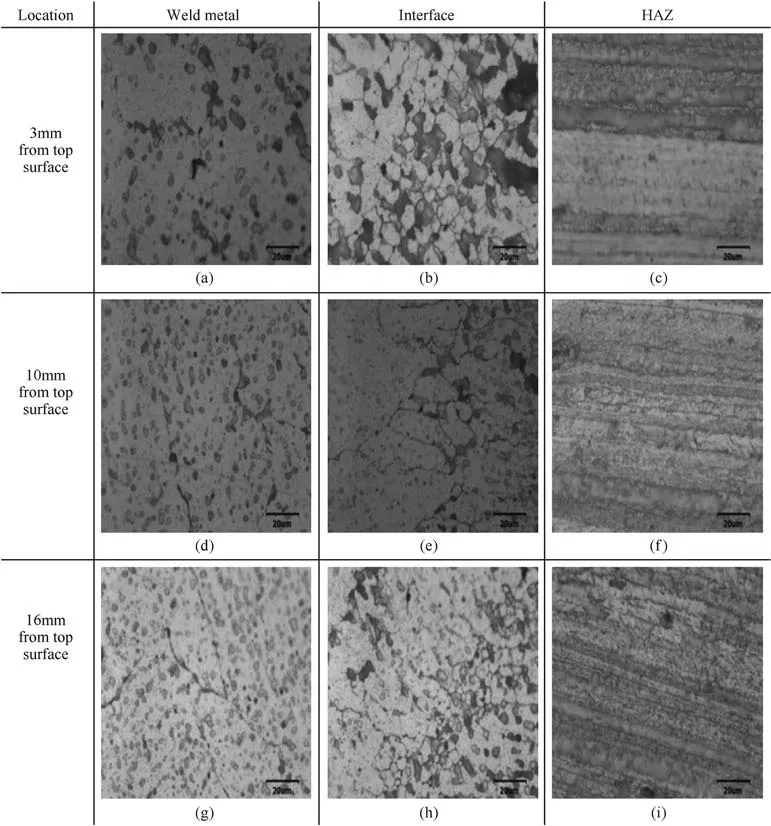
Fig. 8. Micrograph of the various regions of GTAW joint.
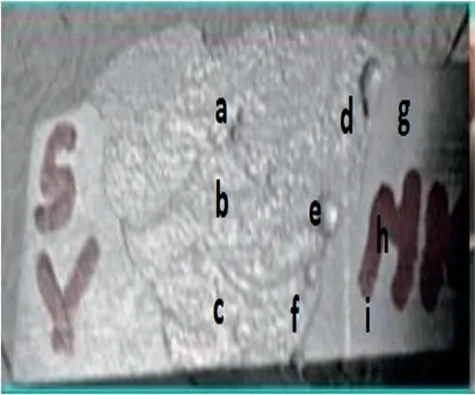
Fig. 9. Macrostructure of the GMAW joint.
4. Discussion
4.1. Effect of welding processes on tensile properties
In this investigation,the reduction in tensile strength of GTA and GMA welded joints resulted in annealing and associated loss of work hardening in the HAZ.However,GTA welded joints exhibited improved tensile properties compared to GMA welded joints. This may be due to lesser vaporization of volatile elements and less reduction in solid solution strengthening with GTAW process which results in preventing the grain growth and formation of finer grains in the weld metal zone. This is the reason why the better tensile properties are recorded for GTA welded joints.Generally,the reduction in ductility during fusion welding process is due to the creation of coarser columnar grains in the HAZ [17]. Therefore the drop in the ductility observed for both GMA and GTA welded joints.But the reduction in ductility for GTA welded joints is less compared to GMAW joints. The mechanical properties of GTA and GMA welded joints mostly depends on the defects and metallurgical changes during welding.A compositional variation in the alloy is the criteria for poor tensile properties in GMAW joints.
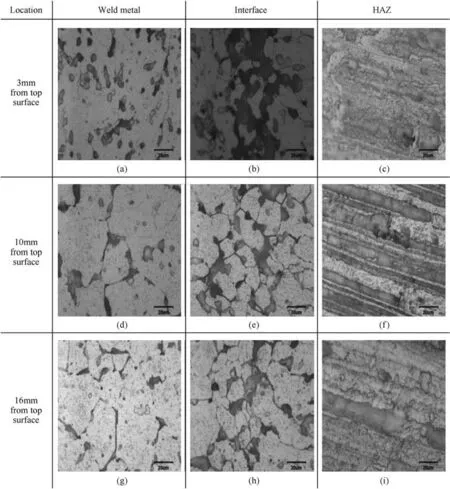
Fig.10. Micrograph of the various regions in GMAW joint.
4.2. Effect of welding processes on microhardness
The hardness distribution along the cross section of both GTA and GMA welded joints are shown in Figs.6 and 8 respectively.The hardness values for the GTA welded joints are higher than the GMA welded joints. We know that the hardness decreases for the high heat input process regardless of the zones. Due to the slower cooling rate in GMA welded joints, the dendrite arm spacing increases. Indeed the hardness value reduces for the larger dendrite arm spacing.
It is clearly seen from the hardness results that weld metal shows lower hardness than other regions for both the GTA and GMA welded joints. Therefore the size and structure of the grown precipitates are also predominant factors in the WM softening behaviour of the welding joint. Moreover, the precipitates are distributed uniformly in the HAZ region and the size of the precipitates is finer.This might be the primary criteria of getting higher strength for the joints fabricated by GTAW process. The size and distribution of Al3Mg2precipitates play a significant role in deciding the tensile properties and hardness of the weld metal region of the AA5059 alloy [18]. GTAW joints records higher hardness than the GMAW joints because of the presence of the intermetallic compounds. The hardness values of GMAW joint are less than that of the GTAW joints because of the dissolution of the intermetallic compounds. During GMA welding, these precipitates are dissolved and therefore the weld metal is free from any precipitates. Because of the faster cooling rates associated with GTA welding,all the precipitates do not dissolve,only few gets dissolved and few exists in a needle shaped precipitates throughout the matrix.
4.3. Effect of welding processes on microstructure
The micrograph of the weld metal region of the GTAW joint is shown in Fig.10. The recrystallization and grain growth occurs at the regions near the weld metal zone due to the thermal cycling effect. The peak thermal cyclic temperature which is above the recrystallization temperature decreases as we move away from the weld metal zone.Therefore,it is noticed that recrystallization alone occurs without any grain growth near to the weld metal zone,whereas partial recrystallization happens away from the weld center.The HAZ region consists of coarser grain structure than the remaining regions, because of the thermal effect during the welding process[19].The SEM studies conducted on all the two welded samples have shown clear variation in the presence of the intermetallic compound Al6(Fe,Mn). The joint welded with GTAW process contains the intermetallic compound as shown in Fig. 8,whereas the joint welded with GMAW process shown in Fig. 10 does not contain the intermetallic compounds.
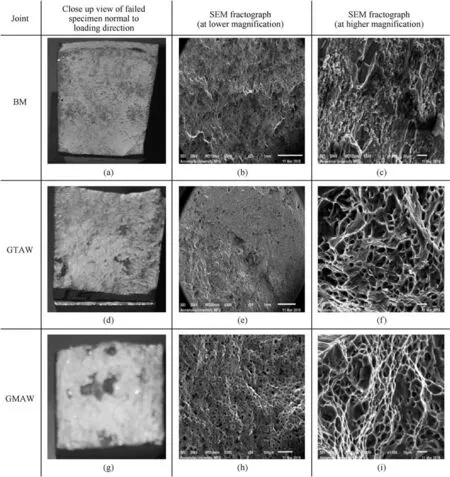
Fig.11. SEM fractographs of the smooth tensile specimens.
It is well known that the mechanical properties of the welded joints especially tensile properties are significantly affected by the loss of alloying elements caused by the evaporation.In this aspect,the reduction in the percentage of magnesium and manganese obviously affects the tensile properties of both GTA and GMA welded joints. The 39 wt % loss of magnesium in the GMA welded joints is the main reason for the reduction in yield strength value.The improvement of yield strength in GTA welds is because of the small increase in the magnesium content,which are contradictory[20]. In both GTAW and GMAW joints, the softening occurs in the WM region which leads to the reduction of tensile properties as a result of recrystallization and grain growth in the WM. It is confirmed from the microstructure of WM region as shown in Fig.8(b)&(c)and 10(b)&(c).However the effect of softening is more in case of GMAW joints compared to the GTAW joints. Moreover, in addition to the WM softening,the precipitate size also plays a vital role in influencing the mechanical properties. The coarser size of the precipitates and the higher level of softening in case of GMAW joints occurs due to the high heat generation involved in this process.
5. Conclusions
The conclusions drawn from this research study are
(1) GTAW joints showed 10%higher tensile strength than GMAW joints. The percentage of elongation of both GTAW and GMAW joints are nearly the same.
(2) Hardness profile revealed that the minimum hardness is recorded in the weld metal zone of GTAW and GMAW joints.This is because of the softening mechanism that occurs in the weld metal caused by the additional thermal cycles after each weld pass.
(3) Vaporization of volatile elements such as magnesium is more in GMAW weld metal than in GTAW weld metal due to higher heat input associated with GMAW process. This causes drop in tensile strength of the GMAW joints.
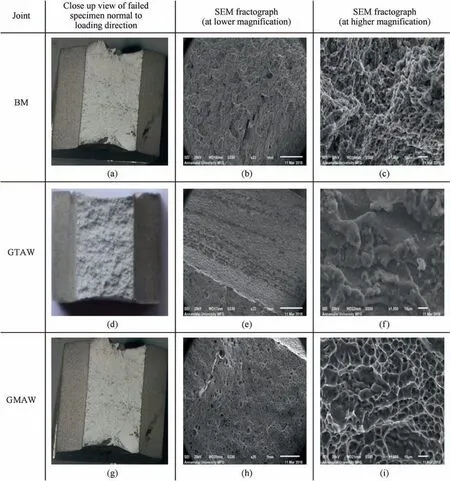
Fig.12. SEM fractographs of the notch tensile specimens.
Acknowledgment
The authors express their sincere gratitude to the Center for Materials Joining and Research (CEMAJOR), Department of Manufacturing Engineering, Annamalai University, Annamalai Nagar, India for providing the facilities and bringing out this investigation.
杂志排行
Defence Technology的其它文章
- Body armour - New materials, new systems Ian G. Crouch*
- Special materials in pyrotechnics VII: Pyrotechnics used in thermal batteries☆
- Real-time calculation of fragment velocity for cylindrical warheads
- Heavy metal free primers: Polymorphism of gadolinium and titanium in the context of GSR glass phase Felice Nunziata
- Mitigation of EDFA transient effects in variable duty cycle pulsed signals
- Ballistic impact properties of woven bamboo- woven E-glassunsaturated polyester hybrid composites
